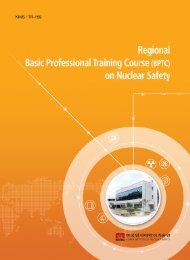PROSPER guidelines - Nuclear Safety and Security - IAEA
PROSPER guidelines - Nuclear Safety and Security - IAEA
PROSPER guidelines - Nuclear Safety and Security - IAEA
You also want an ePaper? Increase the reach of your titles
YUMPU automatically turns print PDFs into web optimized ePapers that Google loves.
4.4.4. Trending <strong>and</strong> trend review<br />
1. Are events “categorized/coded” in any way <strong>and</strong> trended (e.g. plant code, equipment,<br />
personnel, procedures, management process, direct causes, root causes, significance,<br />
reporting criteria met, etc.)?<br />
2. Is the trending system utilized comprehensive in specification (equipment, personnel, <strong>and</strong><br />
processes, etc.)? Are the criteria for categorization/coding specified adequate for trending<br />
purposes? Is the application of consistent categorization/coding apparent?<br />
3. Is the system capable of allowing user friendly/flexible searches on trends to be<br />
conducted?<br />
4. Are regular trend reviews carried out? Are reports prepared <strong>and</strong> summaries issued? Are<br />
they relatively timely <strong>and</strong> relevant?<br />
5. Are adverse trends reviewed <strong>and</strong> corrective actions taken.<br />
6. Is their a routine management review/significance review carried out <strong>and</strong> are actions taken<br />
on the results of the reviews. Is this evident in the action plans of the plant<br />
7. How are the key issues identified? Comment on the key safety issues — are equipment,<br />
procedural <strong>and</strong> personnel issues identified. Comment on their ratios.<br />
8. What are the unresolved key safety issues identified by the trending process? Comment on<br />
their significance to safety (consequences, causes, production). Comment on the priority<br />
given to corrective action by the plant.<br />
9. Do these unresolved safety issues show a weakness in; the ability to identify issues before<br />
they result in failures/events, the ability to adequately <strong>and</strong> comprehensively analyse the<br />
identified issues; or a failure to implement appropriate <strong>and</strong> comprehensive corrective<br />
measures in a timely manner? Is the ability to identify, analyse or correct issues trended<br />
over the years?<br />
10. Is the significance to safety of the consequences of the events trended over the years?<br />
Should positive or adverse trends be commented upon?<br />
4.4.5. External operating experience review<br />
1. Are external OE reports screened adequately? Is too little (or too much) information<br />
introduced into the plant OE process? Are the personnel responsible for screening suitably<br />
experienced? Do they have adequate resources to conduct their duties?<br />
2. How do the staff determine whether the external operational experience report is relevant<br />
to the plant? Are relevant external OE reports adequately assessed <strong>and</strong> timely circulated<br />
for information?<br />
3. Where necessary are appropriate actions from external events placed <strong>and</strong> tracked?<br />
4.4.6. Action management programme<br />
1. Are the corrective actions proposed specific, measurable, achievable, realistic <strong>and</strong> can they<br />
be implemented in a timely manner? Are they positively stated, understood, relevant <strong>and</strong><br />
comprehensive?<br />
2. Are short term corrective action programmes put in place when the proposed<br />
comprehensive actions require considerable time to fully implement?<br />
3. Are corrective actions systematically prioritized to specific criteria? Do these criteria<br />
consider relevance to safety? Is risk analysis carried out when considering prioritization?<br />
How is the prioritization of actions decided? What criteria are considered?<br />
34
















